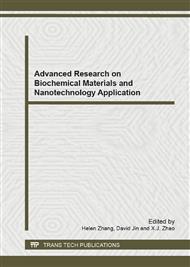[1]
A.B. Prevot, C. Baiocchi, M.C. Brussino, E. Pramauro, P. Savarino, V. Augugliaro, G. Marci and L. Palmisano. Environ. Sci. Technol. Vol. 35 (2001) 971.
DOI: 10.1021/es000162v
Google Scholar
[2]
I.A. Salem, M.S. El-Maazawi. Chemosphere. Vol. 41 (2000) 1173.
Google Scholar
[3]
A.B. Prevot, C. Baiocchi, M.C. Brussino, E. Pramauro, P. Savarino, V. Augugliaro, G. Marci and L. Palmisano. Environ. Sci. Technol. Vol. 35 (2001) 971.
DOI: 10.1021/es000162v
Google Scholar
[4]
B. Neppolian, H.C. Choi, S. Sakthivel, B. Arabindoo and V. Murugesan. Chemosphere. Vol. 46 (2002) 1173.
DOI: 10.1016/s0045-6535(01)00284-3
Google Scholar
[5]
M. Saquib and M. Muneer. Dyes Pigments. Vol. 56 (2003) 37.
Google Scholar
[6]
N. Negishi, T. Iyoda, K. Hashimoto and A. Fujishima. Chem. Lett. Vol. 9 (1995) 841.
Google Scholar
[7]
R. Asahi, T. Morikawa, T. Ohwaki, K. Aoki and Y. Taga. Science. Vol. 293 (1995) 269.
Google Scholar
[8]
M.R. Hoffmann, S.T. Martin, W. Choi and D.W. Bahnemann. Chem. Rev. Vol. 95 (1995) 69.
Google Scholar
[9]
X. Fu, W.A. Zeltner and M.A. Anderson. Appl. Catal. B: Environ. Vol. 6 (1995) 209.
Google Scholar
[10]
K. Tennakone and I.R.M. Kottegoda. J. Photochem. Photobiol. A: Chem. Vol. 93 (1996) 79.
Google Scholar
[11]
R.W. Matthews. J. Catal. Vol. 111 (1988) 264.
Google Scholar
[12]
K.I. Tennakone and R.M. Kottegoda. J. Photochem. Photobiol. A. Vol. 93 (1996) 79.
Google Scholar
[13]
W.S. Kuo and Y.T. Lin. J. Environ. Sci. Health B. Vol. 35 (2000), 61.
Google Scholar
[14]
J. Krýsa, M. Keppert, G. Waldner and J. Jirkovský. Electrochim. Acta. Vol. 50(2005) 5255.
DOI: 10.1016/j.electacta.2005.01.054
Google Scholar
[15]
S.T. Martin, H. Herrmann, M.R. Hoffmann. J. Chem. Soc. Faraday Trans. Vol. 90 (1994) 3315.
Google Scholar
[16]
S. Irmak, E. Kusvuran and O. Erbatur. Appl. Catal. B: Environ. Vol. 54 (2004) 85.
Google Scholar
[17]
K. Vinodgopal, S. Hotchandani and P.V. Kamat. J. Phys. Chem. Vol. 97 (1993) 9040.
Google Scholar
[18]
M.E. Osugi, G.A. Umbuzeiro, M.A. Anderson and M.V.B. Zanoni. Electrochim. Acta. Vol. 50 (2005) 5261.
Google Scholar
[19]
SA Haque, S, Koops, N. Tokmoldin, JR. Durrant, J. Huang , E. Palomares. Adv Mater. Vol. 19(2007) 683.
Google Scholar
[20]
P.V. Kamat. Chem. Phys. J. Vol. 111 (2007) 2834.
Google Scholar
[21]
B. Neppolian, H. Yamashita, Y. Okada, H. Nishijima, M. Anpo. Catal Lett. Vol. 105 (2005) 111.
Google Scholar
[22]
B. Neppolian, H. S. Jie, J. P. Ahn, J. K. Pare, M. Anpo. Chem. Lett. Vol. 33 (2004) 1562.
Google Scholar
[23]
W. Y. Teoh, R. Amal, L. Madler, S. E. Pratsinis. Catal. Today. Vol. 120 (2007) 203.
Google Scholar
[24]
Y. Cong, J. L. Zhang, F. Chen, M. Anpo. Chem. Phys. C. Vol. 111 (2007) 6976.
Google Scholar
[25]
H. Usui, O. Miyamoto, T. Nomiyama, Y. Horie and T. Miyazaki. Sol. Energy Mater. Sol. Cells. Vol. 86 (2005) 123.
Google Scholar
[26]
Y. Ma and J.N. Yao. Chemosphere. Vol. 38 (1999) 2407.
Google Scholar


